The jewels


Jewelry manufacturing in Phoenicia was present from the Canaanite period, more than handicrafts, it is an art that was related to a rich Levantine artistic tradition. The treasures found at Byblos and Ugarit, dating III° and II° millennia have included pectorals and gold medallions, worked in “repoussé” or “cloisonné”, and inspired from Egyptian styles. Decorative motifs and patterns of these centuries, were common during the first millennium, in Phoenician period(1).
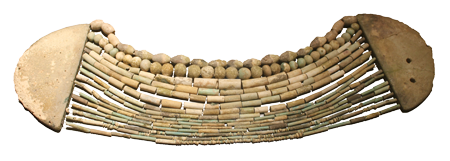
The materials fabricated were fairly different. Gold, seen its preservation quality remained the most commonly used. The silver was also manufactured, but due to its alteration with time, specimens that have survived are less numerous. Bronze, precious stone, polychrome glasses, carnelian and Faience, were, inter alia, some of materials in jewelry compositions(2).
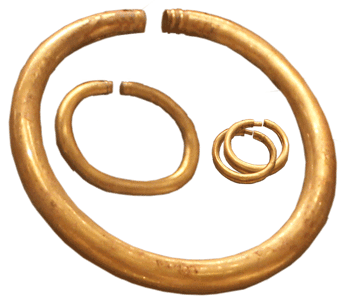
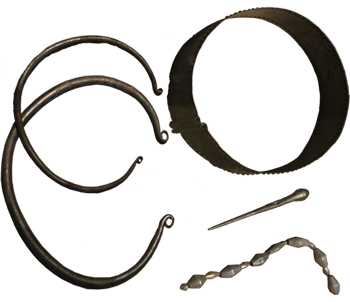
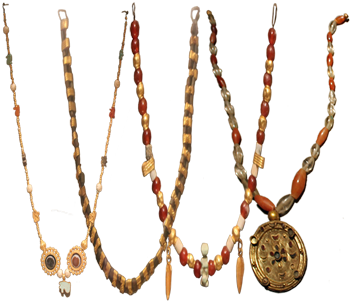
The dominant patterns were either religious or plant themes inspirations, such as lotus flower, palmette, rosette, or animal themes such, scarab, hawk, sphinx, griffin and lion without forgetting geometric ornaments. The most widespread models are the gold earrings shaped ankh (crux ansata: cross with handle), crescent, leech, elongated sticks, or bushel. As well as rings, with a rectangular Bezel or with rounded corners, the shape of a cartridge, often decorated with Egyptian-style(3).
Production consisted in all sorts of creations, combining noble materials like gold as well as precious and semi-precious stones. Women were fond of these accessories, which shine by its value and originality. In the XV of the Odyssey, Eumaios relates his childhood on the island of Syria, his education by a Phoenician governess and her abduction by Phoenician merchants:
"Their messenger, a very cunning fellow, came to my father's house carrying a gold necklace with amber beads strung among it. While in the great hall, my mother worshiped and her servants had the necklace in their hands admiring it and negotiating it price, he made a discreetly sign to the girl and then went back to the hollow of his ship".
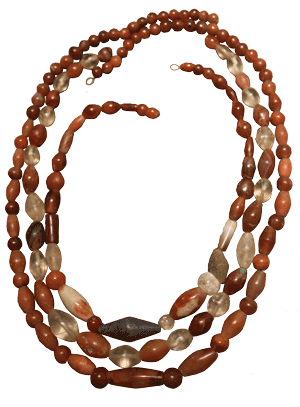
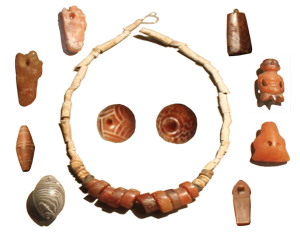
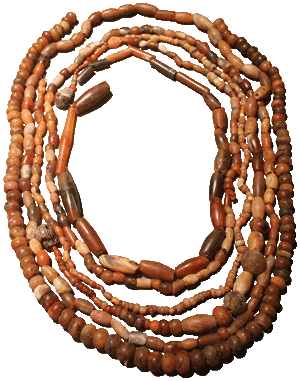
Showcases of the National Museum of Beirut summarizes the story of the Phoenician jewelry creation by exposing a beautiful collection of gold necklaces, earthenware or carnelian, pendants, rings, bracelets and earrings.
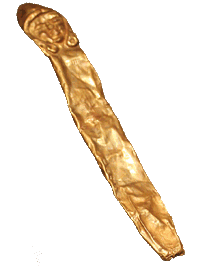
In West Phoenicia, at Carthage, Tharros or in the Iberian Peninsula, the craftsmen where long-time inspired by the Levantine models, before applying their own representations. Among the most beautiful creations, decorated pendants with religious symbols such as "uraei" or granulated solar disk, decorated bracelets with Phoenician palmettes, beetles Egyptianizing or other lucky-charm motifs. The technical processes "granulation, filigree, cloisonné" are brought by Phoenicians since the ninth century in the Greek area: Crete and Attica and since the VII century in Etruria(4).
The Punic art(5) has progressively superimposed over Phoenician art and has begun to distinguish since the seventh century BC. Therefore, the term "Punic" could be applied to all artistic productions of Carthage and its colonies, except for objects imported from the East Phoenicia.
Phoenician and Punic arts have evolved within different cultural contexts. Phoenician art, successor of artistic experience of the II millennium, has developed, since its origins in its eastern environment, contacts with various Syro-Palestinian influences, Assyrian and especially Egyptian which constitute for him a source of inspiration. Punic art has progressed not only in contact with his country of origin, but also, directly or through Eastern Phoenicians, in contact with Egypt, Etruria and specifically with the Greek Sicily in Hellenistic period. These various contributions have influenced and enriched differently, the Phoenician art relative to the Punic art.
Punic jewelry usually has their analogous in the East Phoenicia. The various types of discoid pendants Egyptian-decorated, pins, bushels, solar-disk (Ankh) and crescent-moons have existed around the same time in the principal center of the Punic jewelry, in Carthage, Tharros, Cadiz, Ibiza, Malta or in the Phoenician colonies of Cyprus between the seventh and sixth centuries. The mobile bezel rings, with or without crimping, and rings fixed bezel shaped cartridges, were popular during these two centuries in the East and the West.

Apart from Phoenician models standardized of the seventh century BC, workshops were providing specific characteristics. If Carthage spread its design in its colonies, the city of Tharros in Sardinia has established itself as a major center for the production of silver jewelry and is distinguished, inter alia, by the production of green jasper scarabs which settings were made of gold and silver. Further the goldsmith has experienced variants from the sixth century; pendants decorated with the sign of Tanit in Carthage and earrings Tharros.
In addition to conventional materials, Phoenicians excelled in using glass paste, especially for making beads and pendants, which have brought originality and revolutionized this luxury handicraft.
One of the most common techniques in the elaboration of pendants figures, and elements of the collar, the technique was called "for manufacturing sand cores of core sand or clay or friable." This wet core was adapted according to the desired shape, it was wrapped in a piece of canvas, and it is fixed at the extremity of a stick and plunged into the crucible filled with molten glass. In a second time, it twirled over a metal or stone plate, in order to obtain a smooth and homogeneous surface and then the nucleus was removed(6).
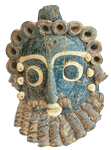
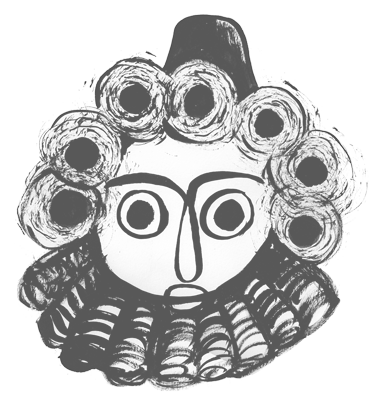
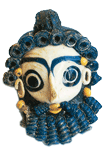

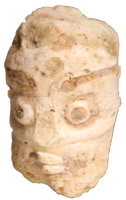

This job requires a number of immersions and retouching, it could also assist by using molds. Highly specialized personnel were indispensable, and long periods of work and preparation of raw materials were requested for an even more complex than the metals industry(7) technique.
For some specialists, polychrome glass paste is an original invention to replace precious stones whose research was often difficult and expensive. These original jewels were made in the cities of the East Phoenician (Byblos, Sidon, Tyre ...) as well as in the territories under Phoenician influence (Carthage, Tharros, Syracuse, Ibiza).
In terms of iconology, is most often present human heads with curly hair beards, smooth or wavy, women's heads with twisted hair. Well as animal heads (ram, rooster) or forms of monstrous creatures to warding off the evil. In addition to these pendants figure, other models has been created like spherical beads, small tapered tubes, beads engraved ... embellished necklaces.
In observing all those pictures we remark how many these timeless jewels are still relevant to this day. This handicraft still inspires contemporary artists who adapt to the taste of the day.
| (1) | Habib Chamoun-Nicolàs, Négociez comme un Phénicien. Découvrez les Tradeables. ESF Editeur (traduction Claude Tournier). | Retour texte |
| (2) | Cf. Giovanna Pisano, "Les bijoux in Les Phéniciens sous la direction de Sabatino Moscati". Editions Stock 1997. | Retour texte |
| (3) | Ibidem. | Retour texte |
| (4) | Cf. Hatmut Matthäus, "Art phénicien, art orientalisant" in La Méditerranée des Phéniciens, de Tyr à Carthage. Somogy Editions d’Art / IMA. | Retour texte |
| (5) | "Les Puniques sont les Phéniciens d’Occident qui ont développé à partir de Carthage une civilisation originale dans une partie de l’Afrique du Nord et de la Méditerranée occidentale – Malte, Sardaigne, Sicile, Espagne – tout en consolidant et en défendant par la diplomatie et la force les intérêts de tous les Phéniciens contre les Grecs puis les Romains et en assurant la continuité des relations avec les Phéniciens d’orient". Cf. Ahmed Ferjaoui, "Art phénicien, art punique" in La Méditerranée des Phéniciens, de Tyr à Carthage. Somogy Editions d’Art / IMA. | Retour texte |
| (6) | Cf. Maria Luisa Uberti, "le verre" in Les Phéniciens sous la direction de Sabatino Moscati. Editions Stock, 1997. | Retour texte |
| (7) | Ibidem. | Retour texte |